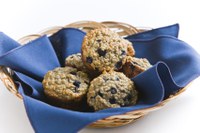Prairie Fare: Kitchens Offer a Summer Learning Lab for Kids
(Click an image below to view a high-resolution image that can be downloaded)
By Julie Garden-Robinson, Food and Nutrition Specialist
NDSU Extension Service
“Mom, what exciting things are we going to do this summer?” my 7-year-old daughter asked.
“I thought we would relax and read,” I replied. I was tired from the week’s activities.
“Relaxing and reading doesn’t sound very exciting,” she noted.
She told me all about her upcoming school activities. To mark the last week of school, the elementary students would enjoy a picnic, field days with outdoor activities, special treats with the principal and several other activities.
I was ready to relax with a book when she finished detailing the entire end of the year school activities. I gave her a few ideas of what we would be doing this summer. She loves to cook and bake, so we started planning some kitchen adventures.
The end of school marks the beginning of summer activities for children. Why not continue their education by inviting kids into the kitchen to help with food preparation? A kitchen can serve as an extension of the school classroom, and children enjoy hands-on activities.
As children read recipes and measure ingredients, they are sharpening their reading, vocabulary and math skills.
Cooking builds self-esteem. Children develop confidence, responsibility and independence when they can help you prepare a snack or meal. When they get more practice, they will be able to prepare more foods on their own.
Cooking teaches children new skills. When kids begin to cook, they can help stir, pour, shake and tear. As they gain experience, they can learn to spread, mix and knead. Later they can cut, grate and measure.
Cooking gives kids a sense of accomplishment. They have a sense of pride when they finish cooking and share what they have made with their family. Cooking helps kids make smart food choices. If you combine gardening with cooking, children learn how foods grow and are more likely to eat more vegetables.
Let them pick out a new fruit or vegetable at the grocery store or farmers market and then prepare the food together. If your children do not eat whole grains regularly, try making some oatmeal muffins or seasoned popcorn for a snack.
Cooking fosters creativity. They can learn about various methods of preparation and flavor combinations. Growing some pots of herbs and using them on pizza and in dips can foster these flavor explorations.
Try to match the task to the development of the child. Age-appropriate tasks will vary for each child depending on how much experience he or she has in the kitchen.
For example, children ages 5 to 7 can help collect ingredients from the cupboard, refrigerator and freezer; stir and mix ingredients by hand; assist in measuring ingredients; and set the timer.
Around ages 8 to 10, they can preheat the oven; use a microwave; use a blender with assistance; and help cut, slice and dice.
If you invite some young helpers into your kitchen, remember safety first. Be sure everyone ties long hair back, wears short sleeves, and washes his or her hands for at least 20 seconds before getting started.
Teach the kids about what surfaces and objects will be hot, and remind them about utensils that are sharp. Be cautious about cords because young children can pull appliances off countertops. Turn handles of pots and pans on a hot stove inward to prevent burns.
For a variety of recipes, nutrition games and family-friendly information, visit the NDSU Extension Service “Eat Smart. Play Hard. Together” website at http://www.ndsu.edu/eatsmart. Find us on Facebook, too.
Gather your ingredients and enlist the help of a young chef this summer. Here’s a tasty muffin recipe courtesy of the Quaker Oats Co.
Lemon Blueberry Oatmeal Muffins
1 3/4 c. Quaker Oats (quick or old-fashioned, uncooked), divided
2 Tbsp. firmly packed brown sugar
1 c. all-purpose flour (add 2 Tbsp. more if using old-fashioned oats)
1/2 c. granulated sugar
1 Tbsp. baking powder
1/4 tsp. salt (optional)
1 c. skim milk
2 egg whites (or 1 whole egg)
2 Tbsp. canola oil
1 tsp. grated lemon peel
1 tsp. vanilla
1 c. fresh or frozen blueberries (do not thaw)
Heat the oven to 400 degrees. Spray 12 medium muffin cups with cooking spray and set aside. For topping, combine 1/4 cup oats and brown sugar and set aside. In a large bowl, combine remaining 1 1/2 cups oats with remaining dry ingredients; mix well. In a small bowl, combine milk, egg, oil, lemon peel and vanilla; mix well. Add to dry ingredients; stir just until moistened, but do not overmix. Gently stir in berries. Fill muffin cups almost full and sprinkle with topping. Bake 18 to 22 minutes or until light golden brown. Cool muffins in pan on wire rack for five minutes. Remove from the pan. Serve warm.
Makes 12 muffins. Each muffin has 180 calories, 3.5 grams (g) of fat, 33 g of carbohydrate, 5 g of protein and 2 g of fiber.
(Julie Garden-Robinson, Ph.D., R.D., L.R.D., is a North Dakota State University Extension Service food and nutrition specialist and associate professor in the Department of Health, Nutrition and Exercise Sciences.)
NDSU Agriculture Communication – May 26, 2011
| Source: | Julie Garden-Robinson, (701) 231-7187, julie.garden-robinson@ndsu.edu |
|---|---|
| Editor: | Rich Mattern, (701) 231-6136, richard.mattern@ndsu.edu |



